The Economic Impact of Climate Risk on Extensive Livestock: The Case of Lamb Production in Extremadura, Spain
Abstract
1. Introduction
2. State of the Art
Production Cycle and Structure of Meat Sheep in Extremadura
“extensive livestock farming takes advantage of the natural resources of the territory, with a low use of external inputs and mainly through grazing. In general, it is characterized by the use of livestock breeds adapted to the territory, the use of diverse pastures depending on their spatial and temporal availability, and the maintenance of the environment”[12] (p. 25).
3. Methods and Data
3.1. The Data
- To estimate the cost structure of the sector, the model of representative farm designed by the Spanish Ministry of Agriculture and Fisheries, Food and Environment for the period 2008–2018 was used. The model results were from the Agri-benchmark scheme, which uses a homogeneous methodology that allows the comparison of the results obtained for all farms, regardless of the place in which they are located. This methodology is fundamentally based on the Typical Farm concept from the TIPI-CAL Calculation Model, a technical-economic analysis tool that allows monitoring of basic financial activities [14,15]. The data of costs and financial activities ranged from 2008 to 2018.
- The two representative models (owner and tenant) of Extremadura were used. The owner model balance sheet is estimated on a stock of 1000 animals, while the tenant is based on 600 animals. Interviews were carried out with specialists from EA group to obtain confirmation that the structure of both schemes is representative of the group of farms associated with EA Group cooperative. Interviews were carried out during 2018 in Badajoz, Villanueva and Mérida as part of research activities of the project 086-18 “Impact of climate change over livestock production”, funded by Fundación Bancaria Caja de Extremadura.
- To analyze the impact on feed price, data provided by the Ministry of Agriculture and Fisheries, Food and Environment of Spain were used. [24]
- For the determination of the land tenure structure of each farm, data of the EA Group were used, where information on the rented and owned land is available from all farms of the sample.
- Regarding climate information, precipitation data sets provided by the meteorology department of the University of Extremadura from primary sources of the National Meteorology Service (AEMET) were used. Meteorological stations of the area with the highest concentration of livestock were selected: Campanario, Don Benito and Monterrubio de la Serena.
3.2. Methodology
- The evolution of costs is analyzed, identifying if there are significant deviations that might be related with unfavorable climatic conditions, specifically rainfall deficits in comparison to historical behavior.
- Series are separated in prices and quantities, in order to evaluate which effect has the greatest impact on cost increases.
- If deviations of variables can be attributed to rainfall deficits, the economic valuation of the phenomenon will be estimated by means of a counterfactual scenario of critical variables. The counterfactual scenario represents which value would have been in a non-extreme scenario. Two counterfactual values are estimated: one for quantities and one for the price. Different criteria to determine the counterfactual value can be applied:
- ○
- A simple average of the entire series
- ○
- A simple series average up to the year prior to the critical event
- ○
- An interpolated value
- ○
- An estimated value according to the trend line estimated by ordinary least squares
- ○
- A theoretical or exogenous value.
3.3. The Extrems-Identification Model
3.4. Extrapolation
4. Results
- In the ownership scheme, the estimated benefit of €43,624 in 2012 was reduced to €15,974, whereas the estimated benefit of €43,323 in 2017 was reduced to €27,019.
- In the renting scheme, the estimated benefit of €9425 of 2012 turned into a negative result of €1031.
5. Conclusions
- there is a relation between precipitation minimums and feed quantity maximums of the series analyzed.
- the major impact of precipitation shortages is an increase in feed supplementation, with an estimated impact to the meat lamb sector of Extremadura of €54.1 million over two years.
- there is a reduction of benefits at the farm level: 50% reduction on average in the ownership scheme and total reduction in the renting scheme, showing negative results during the precipitation shortage of 2012.
Author Contributions
Funding
Acknowledgments
Conflicts of Interest
Appendix A. Cost Structure of Farms. RENGRATI Models for Extremadura
| 2008 | 2009 | 2010 | 2011 | 2012 | 2013 | 2014 | 2015 | 2016 | 2017 | 2018 | |
|---|---|---|---|---|---|---|---|---|---|---|---|
| Crops | 10,910 | 9436 | 7735 | 3991 | 1430 | 9900 | 8762 | 14,159 | 10,424 | 9750 | 14,238 |
| Feed | 20,305 | 14,932 | 35,007 | 37,906 | 60,499 | 36,589 | 31,971 | 33,344 | 39,758 | 54,589 | 40,642 |
| Variable | 9619 | 11,004 | 7294 | 16,164 | 17,994 | 18,211 | 14,511 | 14,137 | 18,984 | 23,167 | 23,779 |
| Fix | 15,083 | 9925 | 10,203 | 10,530 | 11,318 | 11,479 | 11,479 | 11,131 | 11,131 | 11,255 | 12,425 |
| Renting | 0 | 0 | 0 | 0 | 0 | 0 | 0 | 0 | 0 | 0 | 0 |
| Financial | 349 | 1607 | 1415 | 1946 | 1926 | 0 | 16 | 0 | 0 | 0 | 0 |
| Amortization | 2523 | 3597 | 3597 | 3597 | 3597 | 3597 | 3854 | 3854 | 3050 | 4397 | 3922 |
| Total expenditures | 58,789 | 50,501 | 65,252 | 74,134 | 96,764 | 79,777 | 70,594 | 76,626 | 83,347 | 103,158 | 95,006 |
| Total income | 115,709 | 115,413 | 116,548 | 127,721 | 138,482 | 114,262 | 119,206 | 123,383 | 144,032 | 165,172 | 184,787 |
| Benefits | 36,920 | 44,911 | 30,936 | 28,226 | 15,974 | 8374 | 24,343 | 22,488 | 36,417 | 27,019 | 64,601 |
| 2008 | 2009 | 2010 | 2011 | 2012 | 2013 | 2014 | 2015 | 2016 | 2017 | 2018 | |
|---|---|---|---|---|---|---|---|---|---|---|---|
| Crops | 4521 | 6286 | 4062 | 4564 | 4676 | 4742 | 3500 | 3850 | 3840 | 3915 | 3915 |
| Feed | 7628 | 7816 | 7286 | 15,974 | 27,311 | 17,250 | 15,897 | 12,264 | 17,613 | 19,568 | 16,802 |
| Variable | 5984 | 4245 | 4021 | 8751 | 9779 | 9912 | 9234 | 8767 | 8889 | 11,692 | 12,300 |
| Fix | 8474 | 5598 | 6038 | 6574 | 6293 | 6426 | 6383 | 6252 | 6572 | 6372 | 7350 |
| Renting | 12,408 | 14,718 | 17,865 | 10,685 | 10,947 | 11,139 | 10,800 | 11,190 | 11,190 | 10,538 | 10,538 |
| Financial | 551 | 1426 | 1251 | 951 | 551 | 375 | 191 | 0 | 21 | 0 | 0 |
| Amortization | 1613 | 4113 | 4170 | 4494 | 4094 | 4094 | 4094 | 4094 | 4894 | 4528 | 4528 |
| Total expenditures | 41,178 | 44,203 | 44,694 | 51,992 | 63,651 | 53,939 | 50,100 | 46,418 | 53,019 | 56,613 | 55,433 |
| Total income | 61,560 | 56,687 | 62,514 | 64,322 | 63,489 | 60,184 | 61,231 | 61,268 | 64,691 | 69,389 | 59,961 |
| Benefits | 19,059 | 12,484 | 16,980 | 11,461 | −1031 | 5363 | 10,537 | 14,255 | 11,042 | 12,133 | 17,171 |

| FARM 1000-EXT. Meat Sheep. | FARM 600-EXT. Meat Sheep. | |||||||
|---|---|---|---|---|---|---|---|---|
| Expenditures | Mean | SD | Max | Min | Mean | SD | Max | Min |
| Crops | 9158 | 3809 | 14,238 | 1430 | 4352 | 760 | 6286 | 3500 |
| Feed | 36,867 | 13,006 | 60,499 | 14,932 | 15,037 | 6019 | 27,311 | 7286 |
| Variable | 15,897 | 5260 | 23,779 | 7294 | 8507 | 2713 | 12,300 | 4021 |
| Fix | 11,451 | 1383 | 15,083 | 9925 | 6576 | 757 | 8474 | 5598 |
| Renting | 0 | 0 | 0 | 0 | 12,002 | 2293 | 17,865 | 10,538 |
| Financial | 660 | 861 | 1946 | 0 | 483 | 521 | 1426 | 0 |
| Amortization | 3599 | 483 | 4397 | 2523 | 4065 | 856 | 4894 | 1613 |
| Total expenditures | 77,632 | 16,322 | 103,158 | 50,501 | 51,022 | 6551 | 63,651 | 41,178 |
| Total income | 133,156 | 23,258 | 184,787 | 114,262 | 62,300 | 3252 | 69,389 | 56,687 |
| Benefits | 30,928 | 15,050 | 64,601 | 8374 | 11,768 | 5686 | 19,059 | −1031 |
| Feed Price | 228 | 32 | 266 | 161 | 236 | 42 | 284 | 160 |
| Feed in tns | 162 | 54 | 260 | 80 | 62 | 18 | 99 | 36 |
| Feed in tns per sheep | 0.16 | 0.05 | 0.26 | 0.08 | 0.06 | 0.02 | 0.10 | 0.04 |
Appendix B. Feed Price Variability
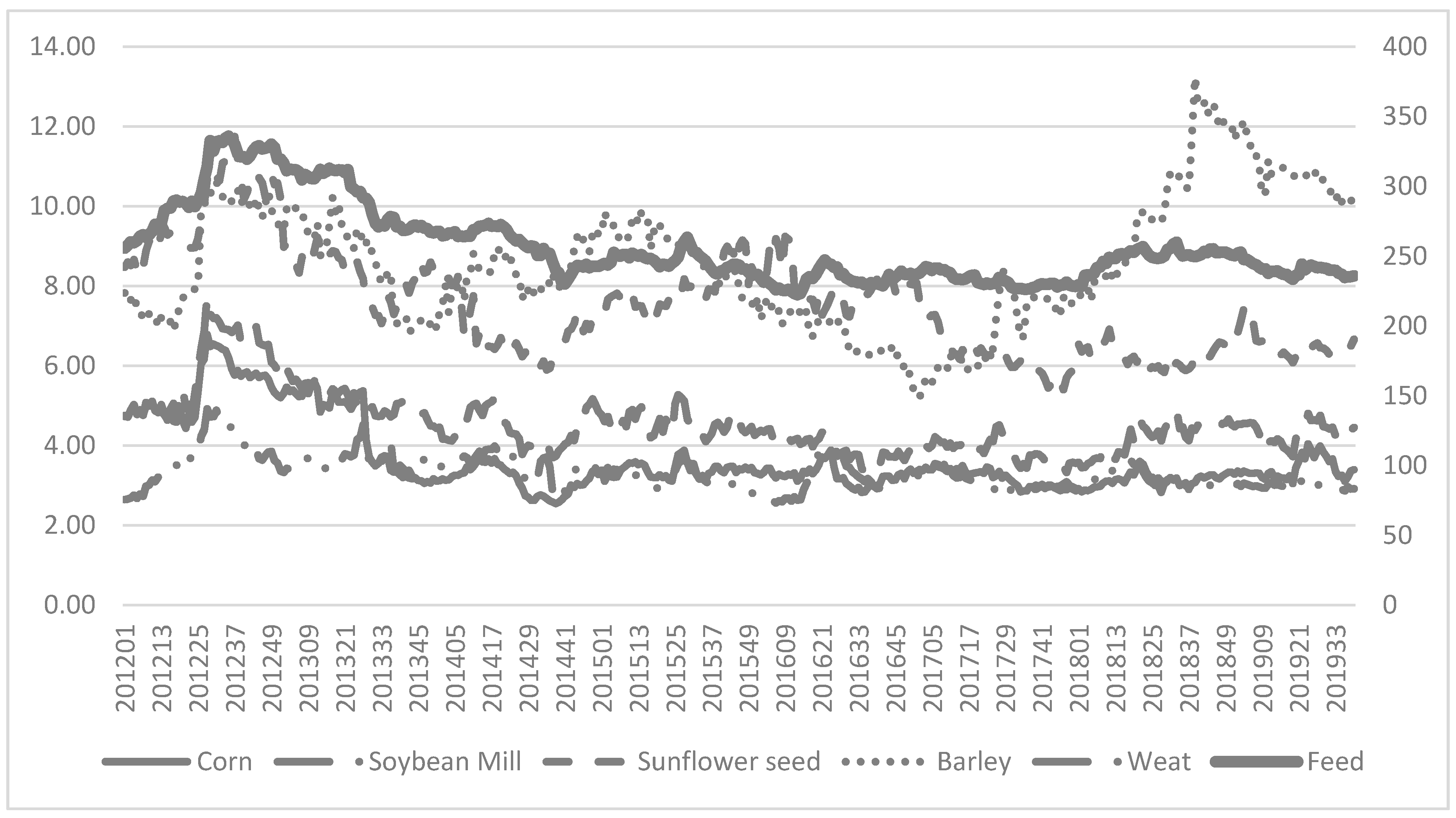
| Dependent Variable: PIENSO | ||||
|---|---|---|---|---|
| Method: Least Squares | ||||
| Sample: 1/13/2012 12/27/2019 | ||||
| Included Observations: 416 | ||||
| Variable | Coefficient | Std. Error | t-Statistic | Prob. |
| C | 32.53264 | 2.405863 | 13.52223 | 0.0000 |
| CEBADA | 0.047925 | 0.014003 | 3.422542 | 0.0007 |
| MAIZ | 0.227812 | 0.024989 | 9.116647 | 0.0000 |
| SOYBEEN | 0.194113 | 0.018139 | 10.70115 | 0.0000 |
| SUNFLOWER | 0.052792 | 0.025340 | 2.083371 | 0.0378 |
| TRIGO | 0.166256 | 0.035119 | 4.734050 | 0.0000 |
| R-squared | 0.847764 | Mean dependent var | 100.2043 | |
| Adjusted R-squared | 0.845908 | S.D. dependent var | 10.79049 | |
| S.E. of regression | 4.235761 | Akaike info criterion | 5.739321 | |
| Sum squared resid | 7356.084 | Schwarz criterion | 5.797456 | |
| Log likelihood | –1187.779 | Hannan-Quinn criter. | 5.762307 | |
| F-statistic | 456.6389 | Durbin-Watson stat | 0.225999 | |
| Prob(F-statistic) | 0.000000 | |||
Appendix C. Precipitation Characterization
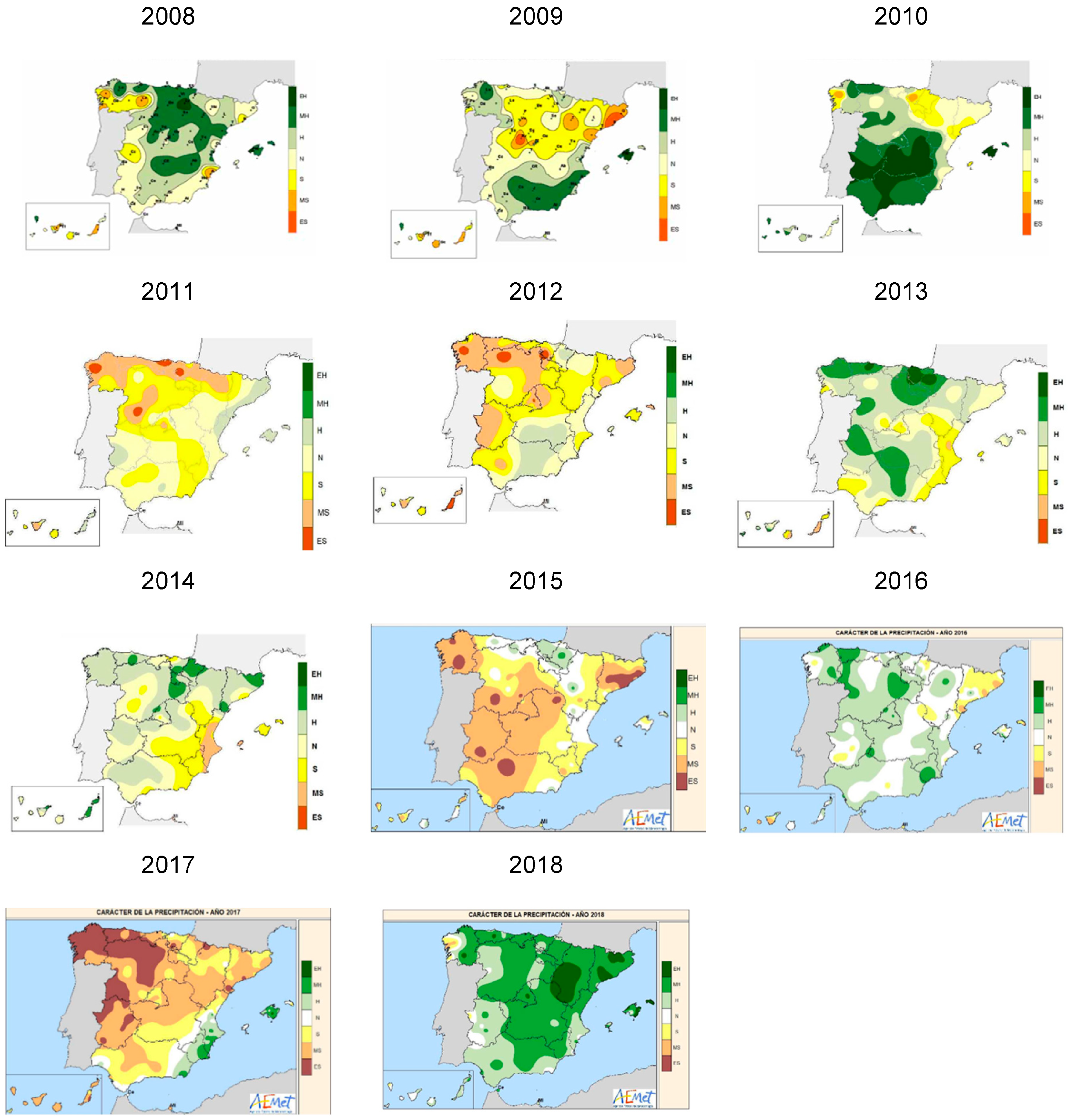
References
- IPCC Special Report. Climate change and land. 2019. Available online: https://www.ipcc.ch/srccl/ (accessed on 23 July 2020).
- Partnership for Research and Innovation in the Mediterranean Area (PRIMA). Available online: http://prima-med.org/ (accessed on 23 July 2020).
- IPCC Climate Change 2014: Impacts, Adaptation and Vulnerability. 2014. Available online: https://www.ipcc.ch/report/ar5/wg2/ (accessed on 18 August 2020).
- Díaz, I.; Achkar, M.; Mazzeo, N. Drought vulnerability assessment of cattle producers in the Sierras del Este-Uruguay: Interactions between actors and agents. Outlook Agric. 2018, 47, 315–325. Available online: https://journals.sagepub.com/doi/abs/10.1177/0030727018808807 (accessed on 23 July 2020). [CrossRef]
- Rubio, A.; Roig, S. Impactos, Vulnerabilidad Y Adaptación En Los Sistemas Extensivos De Producción Ganadera En España. Oficina Española De Cambio Climático. Ministerio De Agricultura Y Pesca, Alimentación Y Medio Ambiente. 2017. Available online: https://www.adaptecca.es/sites/default/files/documentos/informe_ganaderia_extensiva_cambio_climatico.pdf (accessed on 23 July 2020).
- Subdirección General de Productos Ganaderos. Dirección General de Producciones y Mercados Agrarios. In El Sector Ovino Y Caprino De Carne En Cifras; Principales Indicadores Económicos; Ministerio de agricultura: Madrid, Spain, 2018. Available online: https://www.mapa.gob.es/es/ganaderia/publicaciones/indicadoreseconomicosovinoycaprinocarne2018_tcm30-428265.pdf (accessed on 18 August 2020).
- Extremadura21 El Cordero Extremeño Mira Hacia La Meca. 2017. Available online: https://extremadura21.com/2017/01/20/el-cordero-extremeno-mira-hacia-la-meca/ (accessed on 18 August 2020).
- Moore, A.; Ghahramani, A. Climate change and broadacre livestock production across southern Australia. 1. Impacts of climate change on pasture and livestock productivity, and on sustainable levels of profitability. Glob. Chang. Biol. 2013, 19, 1440–1455. Available online: https://onlinelibrary.wiley.com/doi/epdf/10.1111/gcb.12150 (accessed on 23 July 2020). [CrossRef] [PubMed]
- Guidry, K.M.; Pruitt, J.R. Damages to Louisiana agriculture from natural disasters. Choices Mag. FoodFarm Resour. Issues 2012, 27, 1–6. Available online: https://www.jstor.org/stable/pdf/choices.27.3.09.pdf?seq=1 (accessed on 23 July 2020).
- Ziolkowska, J.R. Socio-Economic Implications of Drought in the Agricultural Sector and the State Economy. Economies 2016, 4, 19. Available online: https://www.mdpi.com/2227-7099/4/3/19/pdf (accessed on 23 July 2020). [CrossRef]
- Kachergis, E.; Derner, J.D.; Cutts, B.B.; Roche, L.M.; Eviner, V.T.; Lubell, M.N.; Tate, K.W. Increasing flexibility in rangeland management during drought. Ecosphere 2014, 5, 77. Available online: https://esajournals.onlinelibrary.wiley.com/doi/epdf/10.1890/ES13-00402.1 (accessed on 23 July 2020). [CrossRef]
- Ruiz, J.; Herrera, P.M.; Barba, R.; Busqué, J. Definición y caracterización de la ganadería extensiva en España. In Fund Entretantos Y Minist. De Agric. PescaAliment. Y Medio Ambiente; 2017; Available online: https://www.mapa.gob.es/es/ganaderia/temas/produccion-y-mercados-ganaderos/informesobreganaderiaextensivaenespanaoctubre2017nipo_tcm30-428264.pdf (accessed on 23 July 2020).
- ECREA. Resultados técnico-económicos del Ganado Ovino de carne en 2015. Estudios de Costes y rentas de las Explotaciones Agrarias. Subdirección General de Análisis, Coordinación y Estadística, Subsecretaría. Ministerio de Agricultura, Pesca y Alimentación, Gobierno de España. 2015. Available online: https://www.mapa.gob.es/es/ministerio/servicios/analisis-y-prospectiva/ganadoovinodecarne_tcm30-482451.pdf (accessed on 23 July 2020).
- Ministerio de Agricultura, pesca y Alimentación, Gobierno de España. RENGRATI Red Nacional De Granjas Típicas (OVINO DE CARNE) 1000-EXT: Resultados ejercicio económico ovino de carne. 2017. Available online: https://www.mapa.gob.es/es/ganaderia/temas/produccion-y-mercados-ganaderos/sectores-ganaderos/red-de-granjas-tipicas/ovino-caprino/default.aspx (accessed on 28 August 2020).
- Ministerio de Agricultura, pesca y Alimentación, Gobierno de España. RENGRATI Red Nacional de Granjas Típicas (OVINO DE CARNE) 600-EXT: Resultados ejercicio económico ovino de carne. 2017. Available online: https://www.mapa.gob.es/es/ganaderia/temas/produccion-y-mercados-ganaderos/sectores-ganaderos/red-de-granjas-tipicas/ovino-caprino/default.aspx (accessed on 28 August 2020).
- Schnabel, S.; Pulido, M.; Lavado, J.F. The availability of water in ranches of Mediterranean type climate. In Grupo de Investig. GeoAmbiental Univ. de Extremad.; 2009; Available online: https://pdfs.semanticscholar.org/eeee/e3dea74d17fa17b4f20e157c4d90d1b5a22c.pdf (accessed on 23 July 2020).
- Morales-Reyes, Z.; Navarro-Ríos, M.; Moleón, M.; Mateo-Tomás, P.; Blanco, G.; Botella, F.; Donázar, J.A.; Margalida, A.; Pérez, I.; Valverde, M.; et al. Percepción de los ganaderos sobre la sostenibilidad de los sistemas agroganaderos tradicionales en España en un contexto de cambio global. In Actas XXVI Jorn. Técnicas SEAE X Semin. Agroecol. C. Climático Y Agrotur.; 2017; Available online: http://hdl.handle.net/10261/179061 (accessed on 23 July 2020).
- Amblar, P.; Casado, M.J.; Pastor, A.; Ramos, P.; Rodríguez, E. Guía de Escenarios regionalizados de cambio climático sobre España a partir de los resultados del IPCC-AR5. 2017. Available online: http://www.aemet.es/documentos/es/conocermas/recursos_en_linea/publicaciones_y_estudios/publicaciones/Guia_escenarios_AR5/Guia_escenarios_AR5.pdf (accessed on 23 July 2020).
- Herrera, P.M. Ganadería y cambio climático: Un acercamiento en profundidad. Fundación Entretantos Y Plataforma Por La Ganadería Extensiva Y El Pastoralismo. 2020. Available online: http://www.ganaderiaextensiva.org/wp-content/uploads/2020/03/CuadernoEntretantos6_GanaderiayCC.pdf (accessed on 23 July 2020).
- Escarcha, J.F.; Lassa, J.A.; Zander, K.K. Livestock Under Climate Change: A Systematic Review of Impacts and Adaptation. Climate 2018, 6, 54. Available online: https://www.mdpi.com/2225-1154/6/3/54 (accessed on 18 August 2020). [CrossRef]
- Juana, J.S.; Makepe, P.M.; Mangadi, K.T.; Narayana, N. The Socio-economic Impact of Drought in Botswana. Int. J. Environ. Dev. 2014, 11, 43–60. Available online: https://www.researchgate.net/profile/James_Juana/publication/282132415_Socioeconomic_Impact_of_Drought_in_Botswana/links/560413b608aea25fce30b37e/Socioeconomic-Impact-of-Drought-in-Botswana.pdf (accessed on 23 July 2020).
- Gaspar, P.; Mesías, F.J.; Escribano, M.; Rodriguez de Ledesma, A.; Pulido, F. Economic and management characterization of dehesa farms: Implications for their sustainability. Agrofor. Syst. 2007, 71, 151–162. Available online: https://link.springer.com/article/10.1007/s10457-007-9081-6 (accessed on 18 August 2020). [CrossRef]
- Gaspar, P.; Mesías, F.J.; Escribano, M.; Pulido, F. Sustainability in Spanish Extensive Farms (Dehesas): An Economic and Management Indicator-Based Evaluation. Rangel. Ecol. Manag. 2009, 62, 153–162. Available online: https://doi.org/10.2111/07-135.1 (accessed on 18 August 2020). [CrossRef]
- Precios Pienso. Available online: https://www.mapa.gob.es/es/ganaderia/temas/alimentacion-animal/acceso-publico/precios.aspx. (accessed on 23 July 2020).
- Thomasz, E.; Rondinone, G.; Vilker, A. The economic cost of extreme and severe droughts in soybean production in Argentina. Rev. Contaduría Y Adm. 2019, 64, 1–24. Available online: https://dialnet.unirioja.es/descarga/articulo/6770162.pdf (accessed on 23 July 2020). [CrossRef]
- Tannura, M.A.; Irwin, S.H.; Good, D.L. Weather, Technology, and Corn and Soybean Yields in the U.S. Corn Belt. In Marketing and Outlook Research Report 2008-01; Department of Agricultural and Consumer Economics, University of Illinois at Urbana-Champaign: Champaign, IL, USA, 2008; Available online: https://ageconsearch.umn.edu/record/37501/files/morr_08-01.pdf (accessed on 23 July 2020).
- Thomasz, E.; Casparri, M.; Vilker, A.; Rondinone, G. Medición económica de eventos climáticos extremos en el sector agrícola: El caso de la soja en Argentina. Rev. De Investig. En Modelos Financ. 2016, 4. Available online: http://www.economicas.uba.ar/wp-content/uploads/2016/02/Thomasz-E.-O.-Casparri-M.-T.-Vilker-A.-S.-Rondinone-G.-y-Fusco-M.-Medici%C3%B3n-econ%C3%B3mica-de-eventos-clim%C3%A1ticos-extremos-en-el-sector-agricola-el-caso-de-la-soja-en-Argentina.pdf (accessed on 23 July 2020).
- Heinzenknecht, G. Proyecto riesgo y seguro agropecuario. In Oficina De Riesgo Agropecu; 2011. Available online: http://www.ora.gov.ar/informes/enso.pdf (accessed on 23 July 2020).
- Baethgen, W.E. Climate Risk Management and Adaptation to Climate Change. In Uruguay Climate Change Here and Now Suplementary document for the UNDP Report on Human Development; UNDP Uruguay, Montevideo; Springer: Berlin, Germany, 2010; Available online: https://acsess.onlinelibrary.wiley.com/doi/pdf/10.2135/cropsci2009.09.0526 (accessed on 23 July 2020).
- AEMET. Resumen Anual Climatológico 2018. Available online: http://www.aemet.es/documentos/es/serviciosclimaticos/vigilancia_clima/resumenes_climat/anuales/res_anual_clim_2018.pdf (accessed on 23 July 2020).
- AEMET. Resumen Anual Climatológico 2017. Available online: http://www.aemet.es/documentos/es/serviciosclimaticos/vigilancia_clima/resumenes_climat/anuales/res_anual_clim_2017.pdf (accessed on 23 July 2020).
- AEMET. Resumen Anual Climatológico 2016. Available online: http://www.aemet.es/documentos/es/serviciosclimaticos/vigilancia_clima/resumenes_climat/anuales/res_anual_clim_2016.pdf (accessed on 23 July 2020).
- AEMET. Resumen Anual Climatológico 2015. Available online: http://www.aemet.es/documentos/es/serviciosclimaticos/vigilancia_clima/resumenes_climat/anuales/res_anual_clim_2015.pdf (accessed on 23 July 2020).
- AEMET. Resumen Anual Climatológico 2014. Available online: http://www.aemet.es/documentos/es/serviciosclimaticos/vigilancia_clima/resumenes_climat/anuales/res_anual_clim_2014.pdf (accessed on 23 July 2020).
- AEMET. Resumen Anual Climatológico 2013. Available online: http://www.aemet.es/documentos/es/serviciosclimaticos/vigilancia_clima/resumenes_climat/anuales/res_anual_clim_2013.pdf (accessed on 23 July 2020).
- AEMET. Resumen Anual Climatológico 2012. Available online: http://www.aemet.es/documentos/es/serviciosclimaticos/vigilancia_clima/resumenes_climat/anuales/res_anual_clim_2012.pdf (accessed on 23 July 2020).
- AEMET. Resumen Anual Climatológico 2011. Available online: http://www.aemet.es/documentos/es/serviciosclimaticos/vigilancia_clima/resumenes_climat/anuales/res_anual_clim_2011.pdf (accessed on 23 July 2020).
- AEMET. Resumen Anual Climatológico 2010. Available online: http://www.aemet.es/documentos/es/serviciosclimaticos/vigilancia_clima/resumenes_climat/anuales/res_anual_clim_2010.pdf (accessed on 23 July 2020).
- AEMET. Resumen Anual Climatológico 2009. Available online: http://www.aemet.es/documentos/es/serviciosclimaticos/vigilancia_clima/resumenes_climat/anuales/res_anual_clim_2009.pdf (accessed on 23 July 2020).
- AEMET. Resumen Anual Climatológico 2008. Available online: http://www.aemet.es/documentos/es/serviciosclimaticos/vigilancia_clima/resumenes_climat/anuales/res_anual_clim_2008.pdf (accessed on 23 July 2020).
- Thomson Reuters Eikon Database. Available online: https://eikon.thomsonreuters.com (accessed on 23 July 2020).

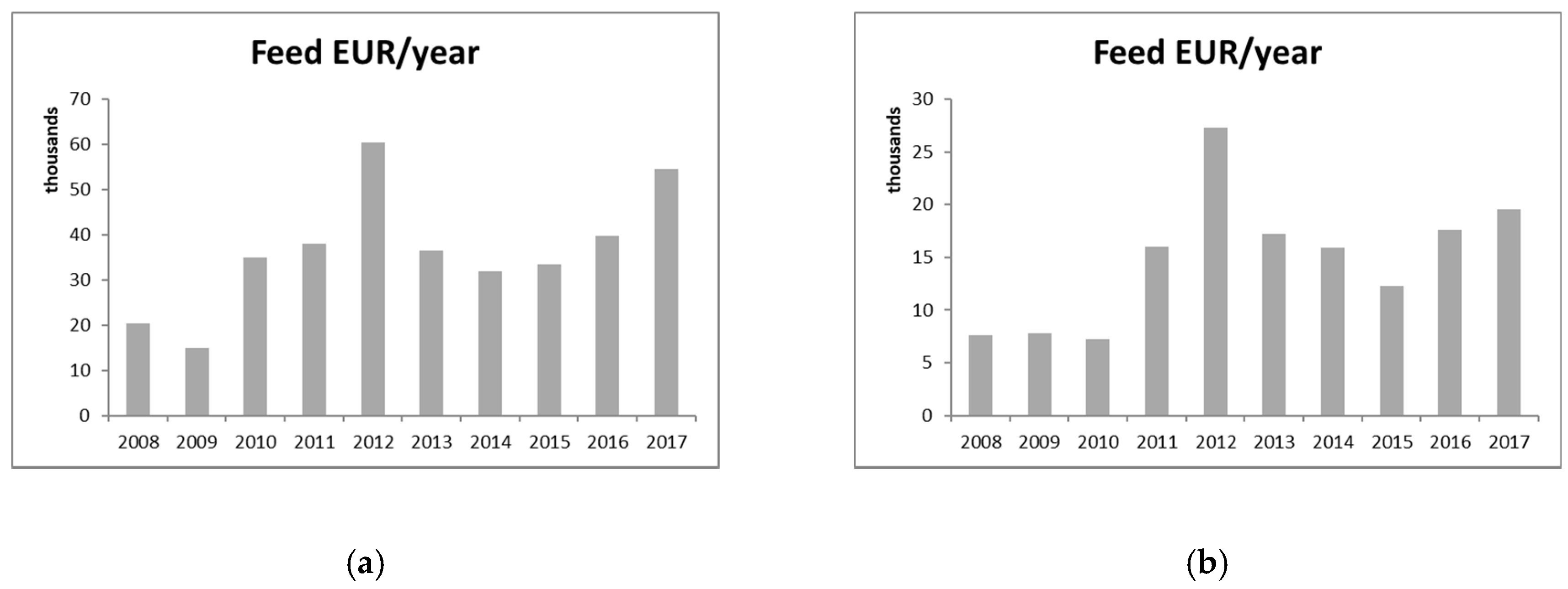
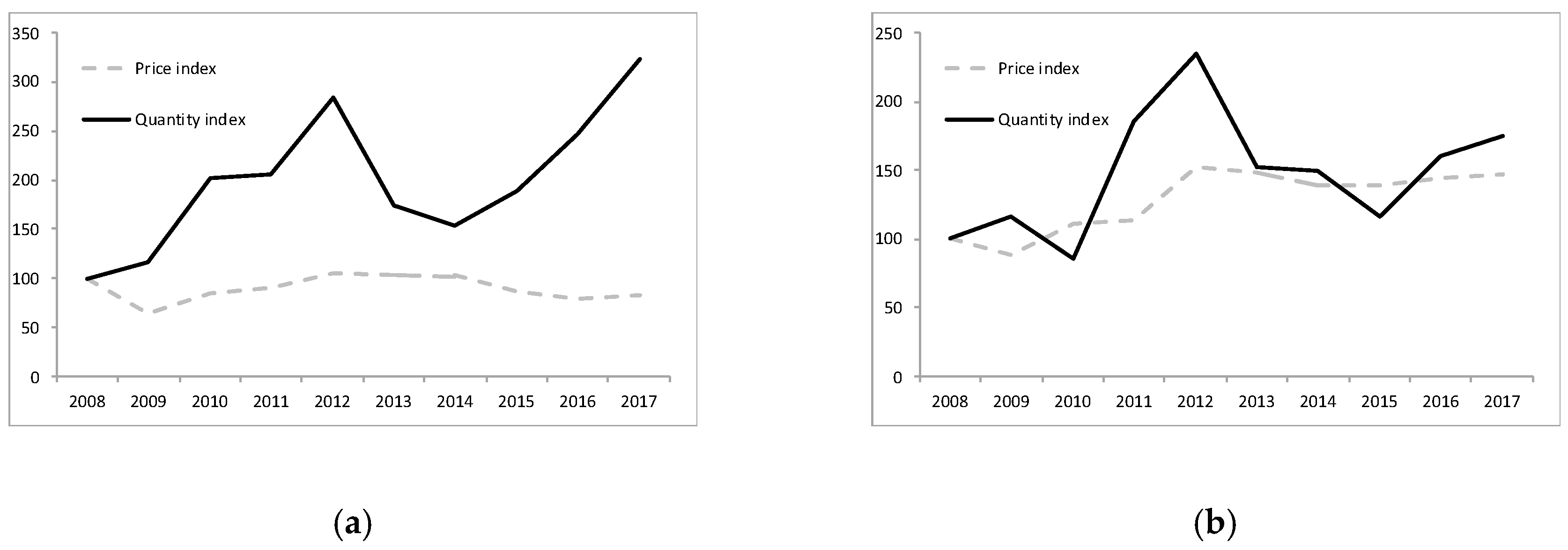
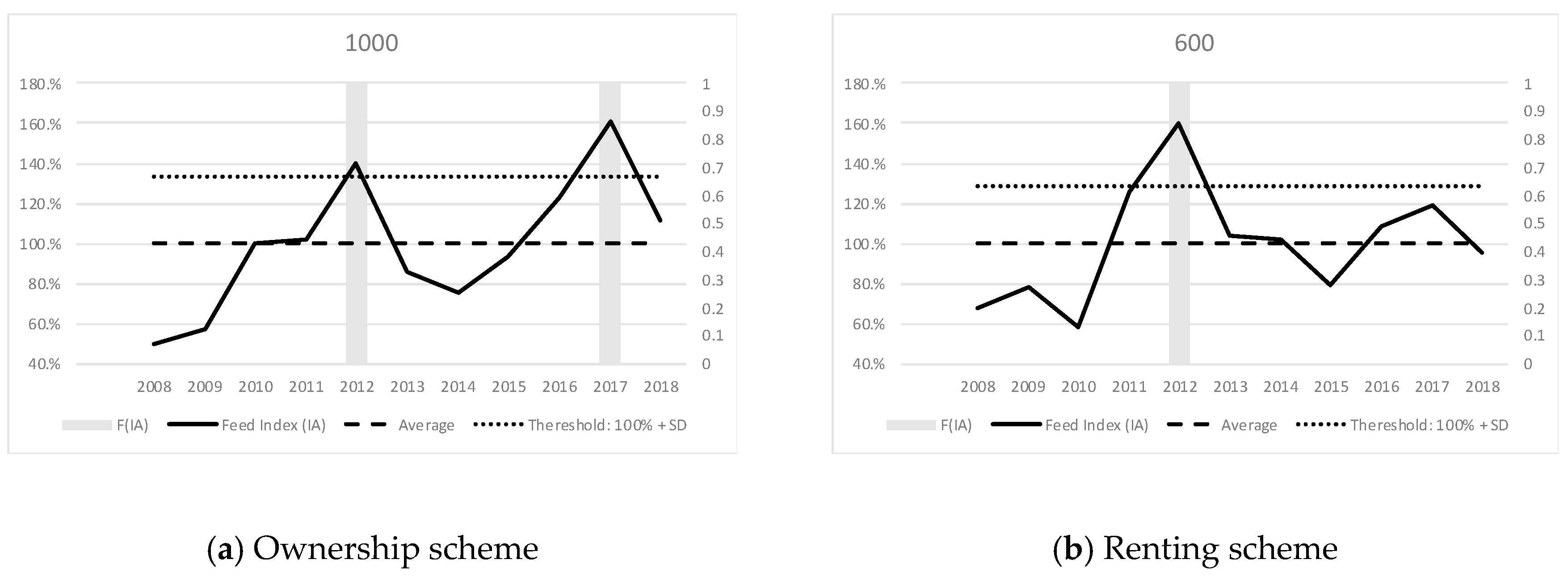
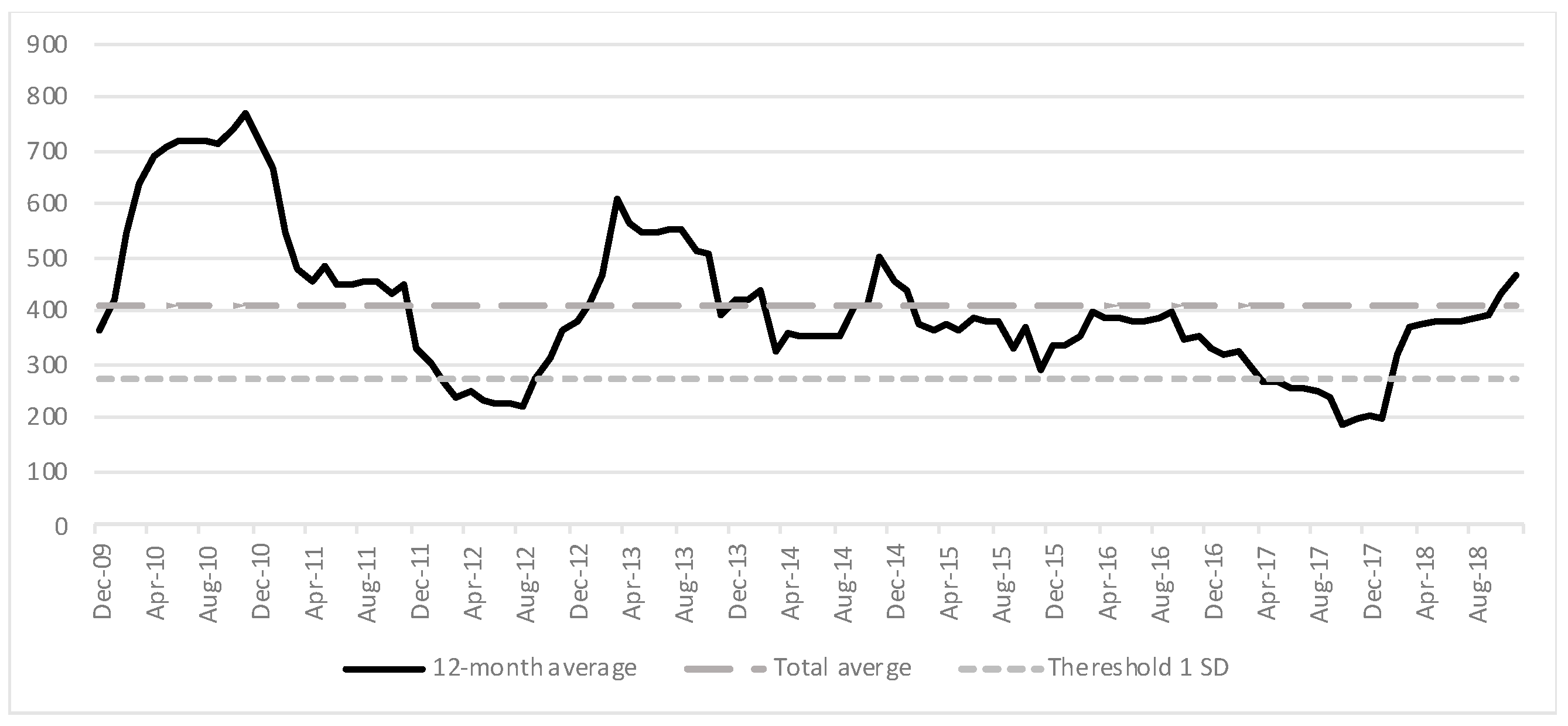

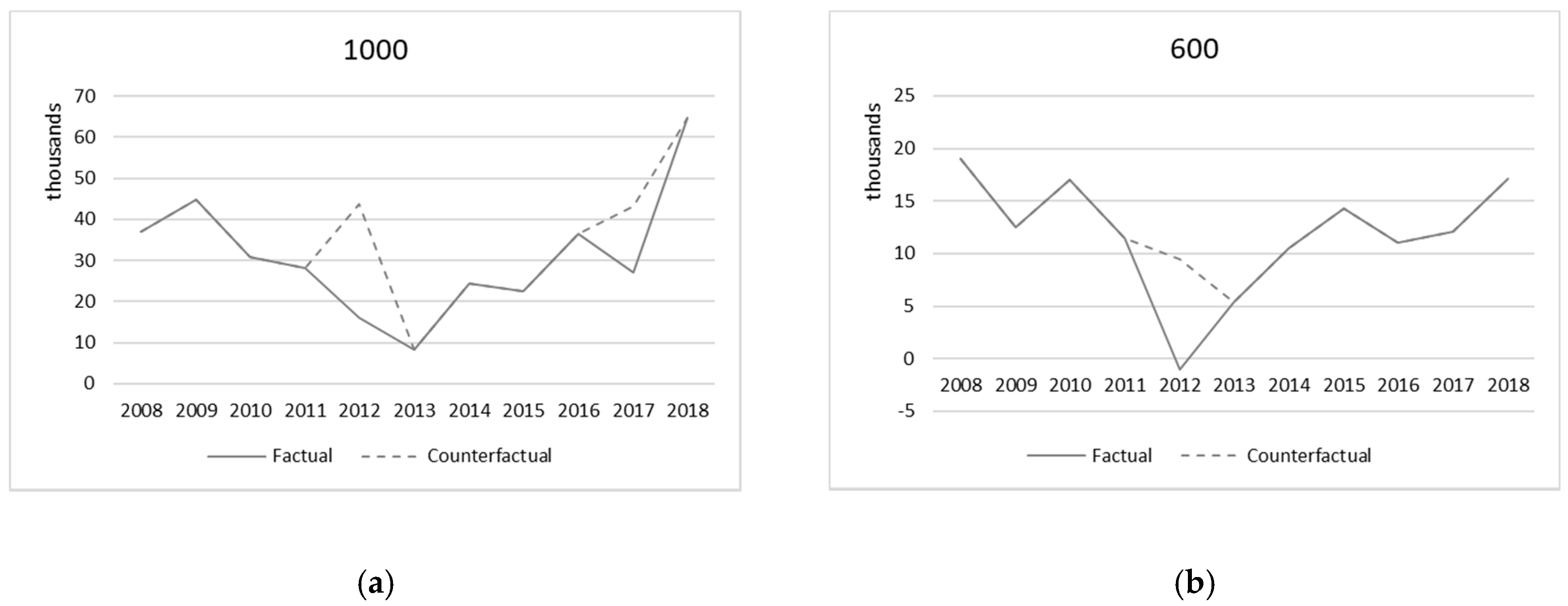
| 2008: Normal, humid | 2014: Normal, humid |
| 2009: Normal, humid | 2015: Very dry |
| 2010: Very humid, extremely humid | 2016: Normal, humid |
| 2011: Normal | 2017: Very dry, extremely dry |
| 2012: Dry, very dry | 2018: Humid |
| 2013: humid, very humid |
| 2012 | 2017 | |
|---|---|---|
| Extreme value feed index (ownership) | ||
| Extreme value feed index (renting) | ||
| Extreme value rainfall | ||
| Incremental cost per animal (ownership) | ||
| Incremental cost per animal (renting) | ||
| Total incremental cost (renting) | ||
| Total incremental cost (ownership) | ||
| Total incremental cost |
© 2020 by the authors. Licensee MDPI, Basel, Switzerland. This article is an open access article distributed under the terms and conditions of the Creative Commons Attribution (CC BY) license (http://creativecommons.org/licenses/by/4.0/).
Share and Cite
Thomasz, E.; Pérez-Franco, I.; García-García, A. The Economic Impact of Climate Risk on Extensive Livestock: The Case of Lamb Production in Extremadura, Spain. Sustainability 2020, 12, 7254. https://doi.org/10.3390/su12187254
Thomasz E, Pérez-Franco I, García-García A. The Economic Impact of Climate Risk on Extensive Livestock: The Case of Lamb Production in Extremadura, Spain. Sustainability. 2020; 12(18):7254. https://doi.org/10.3390/su12187254
Chicago/Turabian StyleThomasz, Esteban, Ismael Pérez-Franco, and Agustín García-García. 2020. "The Economic Impact of Climate Risk on Extensive Livestock: The Case of Lamb Production in Extremadura, Spain" Sustainability 12, no. 18: 7254. https://doi.org/10.3390/su12187254
APA StyleThomasz, E., Pérez-Franco, I., & García-García, A. (2020). The Economic Impact of Climate Risk on Extensive Livestock: The Case of Lamb Production in Extremadura, Spain. Sustainability, 12(18), 7254. https://doi.org/10.3390/su12187254







